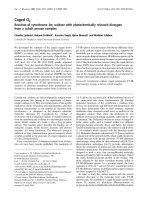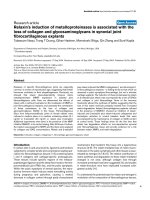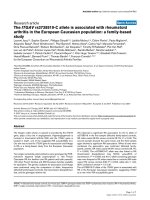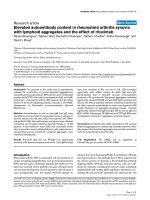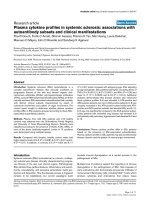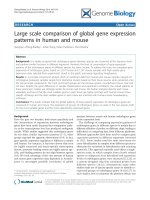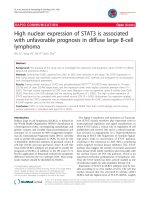Báo cáo y học: "A severe case of erythrodermic psoriasis associated with advanced nail and joint manifestations: a case report" pptx
Bạn đang xem bản rút gọn của tài liệu. Xem và tải ngay bản đầy đủ của tài liệu tại đây (1.04 MB, 3 trang )
JOURNAL OF MEDICAL
CASE REPORTS
Teran et al. Journal of Medical Case Reports 2010, 4:179
/>Open Access
CASE REPORT
BioMed Central
© 2010 Teran et al; licensee BioMed Central Ltd. This is an Open Access article distributed under the terms of the Creative Commons
Attribution License ( which permits unrestricted use, distribution, and reproduction in
any medium, provided the original work is properly cited.
Case report
A severe case of erythrodermic psoriasis associated
with advanced nail and joint manifestations: a case
report
Carlos G Teran*, Carlos N Teran-Escalera and Carola Balderrama
Abstract
Introduction: Erythrodermic psoriasis is a rare generalized clinical presentation of psoriasis in children and adults. Its
systemic involvement and a diverse range of clinical findings in the joint and nails are commonly described. A high
index of suspicion and an exhaustive differential diagnosis involving other causes of erythroderma should be initially
considered.
Case presentation: We present the case of a 9-year-old native Hispanic girl with severe erythrodermic psoriasis
associated with uncommon advanced nail and joint manifestations. Our patient showed an excellent response to
methotrexate medication.
Conclusion: This case shows clinical features not commonly described or reported in severe cases of erythrodermic
psoriasis, including severe and rare nail and arthritic findings in a pediatric scenario.
Introduction
Erythrodermic psoriasis is considered a rare clinical pre-
sentation. It may arise from any type of psoriasis and
occurs in adults, children and babies [1]. It is well known
that trauma, infections and drugs, such as lithium, anti-
malarials, trimethoprim and sulfamethoxazole, as well as
environmental, psychological and metabolic factors can
trigger psoriasis and the erythrodermic form of the dis-
ease [2,3].
The generalized manifestations of the disease are ery-
thema, edema, desquamation and systemic compromise
(fever, dehydration, malaise and malnutrition) [4]. This
disease ranges from mild to severe, as in the case of our
patient
Nail malformations, ranging from mild pitting with yel-
lowish discoloration to severe onychodystrophy, are seen
in all types of the disease. These symptoms are more pro-
nounced in the fingernails than in the toenails. In addi-
tion, several well-designed studies have demonstrated an
association between nail lesions and psoriatic arthritis
[5].
The treatment of erythrodermic psoriasis should
include rigorous control of a patient's hydration and
nutrition. Clinical trials have proven the efficacy of sys-
temic agents such as cyclosporin A or methotrexate,
which should be started as soon as a diagnosis is made
[6,7]. Although less used in severe cases, new immuno-
modulators such as alefacept, efalizumab, etanercept and
infliximab, are recommended in mild cases. Their use in
severe erythrodermic cases has only been reported inci-
dentally [8].
Case presentation
A 9-year-old native Hispanic girl with a history of plaque
psoriasis was admitted to the emergency department of
the Hospital Abina Patiño with a 4-week history of pro-
gressive skin desquamation. The condition started in her
extremities and face, and then rapidly spread over her
whole body.
A physical examination identified that the child was
febrile, in moderate distress and had signs of moderate
dehydration and severe malnutrition. Generalized skin
redness and desquamation were seen over her entire
body surface, accompanied by blepharitis, conjunctivitis
and madarosis which were noted from an ocular exam
(Figure 1). Advanced onychodystrophy in her toenails
* Correspondence:
1
Department of General Pediatrics, Centro Pediatrico Albina Patiño,
Cochabamba, Bolivia
Full list of author information is available at the end of the article
Teran et al. Journal of Medical Case Reports 2010, 4:179
/>Page 2 of 3
and fingernails was noted bilaterally. Swelling, pain, and
rigidity in her knees and elbows were also noted (Figure
2).
Three months before she presented to our hospital, our
patient was clinically diagnosed with plaque psoriasis and
had been treated with topical corticosteroids and mois-
turizing creams. She had no pathological birth or related
family history. Her parents also denied that she had expe-
rienced trauma, drugs, infections or any other similar
triggers for her condition.
Based on the above observations, a clinical diagnosis of
severe erythrodermic psoriasis with arthritis and second-
ary malnutrition was made. This diagnosis was supported
by a histopathological study that showed parakeratosis
and hyperkeratosis, elongation of rete ridges, and neutro-
phil infiltration (Figure 3).
The initial management of our patient's condition
included systemic treatment with methotrexate, fluid
resuscitation, and well-controlled food intake. At the
same time, her conjunctivitis and blepharitis were treated
with artificial tears and antibiotics, respectively. Her skin
was completely desquamated in the following two weeks
and she achieved full skin recovery one month after she
commenced treatment. Her arthritis also recovered in the
first month of treatment and her malnutrition was pro-
gressively addressed with nutritional support. Her nail
recovery, however, took a longer time and treatment to
achieve any notable improvement.
Conclusion
Our case report illustrates clinical features that are not
commonly described and reported in severe cases of
erythrodermic psoriasis, including severe and rare nail
malformations, and arthritic findings in a pediatric sce-
nario.
The time it took for our patient's condition to evolve
from one type to another was short, and without any his-
tory of the triggering factors commonly described in the
literature. The diagnosis of erythrodermic psoriasis is
based on the clinical features and history of her psoriasis,
as well as on histopathological examinations of our
patient's tissue specimens. Any final diagnosis should
include a differential diagnosis which includes severe skin
reaction secondary to drugs, atopic reaction, infections,
and malignancies such as lymphoma and mycosis fungoi-
des which can be clinically indistinguishable from a
severe form of psoriasis. Histopathological studies are
also generally needed to achieve a definitive diagnosis.
Consent
Written informed consent was obtained from the
patient's next-of-kin for publication of this case report
and any accompanying images. A copy of the written con-
sent is available for review by the Editor-in-Chief of this
journal.
Competing interests
The authors declare that they have no competing interests.
Figure 1 (A) Severe skin desquamation and redness over her en-
tire body accompanied by eye compromise (blepharitis, conjunc-
tivitis and madarosis). (B) Swelling and redness in both knees
secondary to arthritis.
Figure 2 Severe onychodystrophy in our patient's (A) fingernails
and (B) toenails.
Figure 3 Histopathological examination showing regular elonga-
tion of rete ridges, hyperkeratosis, parakeratosis and neutrophil
entrapment in the laminar keratin. Dilated vessels and papillae with
cellular inflammatory infiltration are present in the dermis. (A) Hema-
toxylin and eosin staining, 100× magnification. (B) Hematoxylin and
eosin staining, 40× magnification.
Teran et al. Journal of Medical Case Reports 2010, 4:179
/>Page 3 of 3
Authors' contributions
CGT wrote most of the manuscript and aided in the final editing of the text. CB
retrieved most of the information relevant to the case presentation. CNTE was
in charge of our patient and critically reviewed the final manuscript. All the
authors read and approved the final manuscript.
Author Details
Department of General Pediatrics, Centro Pediatrico Albina Patiño,
Cochabamba, Bolivia
References
1. Farber EM, Nall L: Childhood psoriasis. Cutis 1999, 64(5):309-314.
2. Dika E, Bardazzi F, Balestri R, Maibach HI: Environmental factors and
psoriasis. Curr Probl Dermatol 2007, 35:118-135.
3. Fry L, Baker BS: Triggering psoriasis: the role of infections and
medications. Clin Dermatol 2007, 25(6):606-615.
4. Naldi L, Gambini D: The clinical spectrum of psoriasis. Clin Dermatol
2007, 25(6):510-518.
5. Lavaroni G, Kokelj F, Pauluzzi P, Trevisan G: The nails in psoriatic arthritis.
Acta Derm Venereol Suppl (Stockh) 1994, 186:113.
6. Krueger G, Ellis CN: Psoriasis: recent advances in understanding its
pathogenesis and treatment. J Am Acad Dermatol 2005, 53(1 Suppl
1):S94-S100.
7. Leman J, Burden D: Psoriasis in children: a guide to its diagnosis and
management. Paediatr Drugs 2001, 3(9):673-680.
8. Ceović R, Pasić A, Lipozencić J, Murat-Susić S, Skerlev M, Husar K, Kostović
K: Treatment of childhood psoriasis. Acta Dermatovenerol Croat 2006,
14(4):261-264.
doi: 10.1186/1752-1947-4-179
Cite this article as: Teran et al., A severe case of erythrodermic psoriasis asso-
ciated with advanced nail and joint manifestations: a case report Journal of
Medical Case Reports 2010, 4:179
Received: 21 October 2009 Accepted: 15 June 2010
Published: 15 June 2010
This article is available from: 2010 Teran et al; licensee BioMed Central Ltd. This is an Open Access article distributed under the terms of the Creative Commons Attribution License ( ), which permits unrestricted use, distribution, and reproduction in any medium, provided the original work is properly cited.Journal of Medical Case Reports 2010, 4:179
